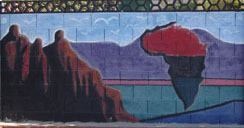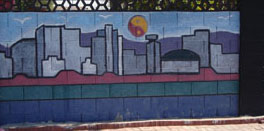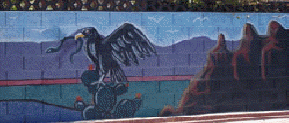|
|
||||
|
As I was walking down one of the smaller
South Phoenix streets, the appearance of the neighborhood caught my
eye. The street that I was walking on was dividing this neighborhood
into two completely different environments. On one side of the street,
the houses were smaller, single story homes and were surrounded by
short chain fences. None of the houses had a garage so the vehicles
were parked in the driveway or by the side walk. The front yards were
filled with residents’ personal items such as furniture, children’s
toys, and other things. It seemed to me as if the front yards were as
living rooms or guest rooms where people would meet and interact. One
of the houses on a side street had a mural painted on it, which was
another important part of Latino culture. James Rojas, in his article, “The Latino Use of Urban Space in East Los Angeles”, describes this type of environment as “permanent or temporary personalization of public space” As soon as I saw these houses I instantly realized that they were occupied by the Latino residents. Although every house has a short fence, it is not to stay away from their neighbors and be isolated. The fences, for Latino residents have a different meaning. The fences bring the neighbors together for interaction, providing a better sense of community for the residents. In such a community where neighbors constantly interact with and know each other, the neighborhood becomes a safer place to live in. On the opposite side of the street was a
newly built subdivision, with larger, two story houses. At first I
thought that none of the houses in this subdivision were occupied
because there was no site of people, cars or anything else in front of
the houses. These homes, of course, are occupied by middle or upper
middle class people, probably all white. Unlike Latinos who express
their culture through creation of “personalized” front yards, the
subdivision residents seem to prefer a totally opposite lifestyle where
they want to be completely isolated from the surrounding. The front
yards are not fenced at all because they are not even used. The whole
subdivision, however, is Even though the subdivision homes are new and expensive, I would not like to be a part of this kind of neighborhood. A community where every house looks exactly the same, with dull, boring, desert color and there is no street activity and social interaction between the neighbors. I have later come to realize that more and more subdivisions are being built in the South Phoenix area. What does this mean for the Latino community and other minority and lower income residents who have been a part of this community for a long time? What kind of an impact is it going to have on the culture and identity of South Phoenix? |
|||
|
||||



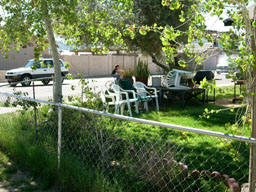
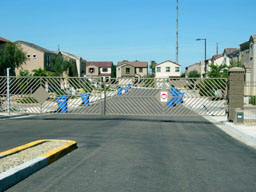 surrounded by a ten foot wall and
so is the each house. The walls prevent neighbors not only from
interacting with but from even seeing each other. Each house has a
garage so people can enter their home through the garage, straight from
their vehicle, this way avoiding any contact with their neighbors. In
her article, “The New Urban Segregation”, Teresa Caldeira points out
that the subdivision communities are “fortified enclaves” in which “the
character of public space and of citizens’ participation in public life
changes”.
surrounded by a ten foot wall and
so is the each house. The walls prevent neighbors not only from
interacting with but from even seeing each other. Each house has a
garage so people can enter their home through the garage, straight from
their vehicle, this way avoiding any contact with their neighbors. In
her article, “The New Urban Segregation”, Teresa Caldeira points out
that the subdivision communities are “fortified enclaves” in which “the
character of public space and of citizens’ participation in public life
changes”. 